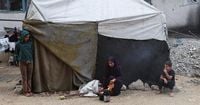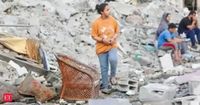After months of devastating conflict and humanitarian catastrophe in Gaza, a glimmer of hope has emerged. On October 8, 2025, a landmark ceasefire deal was announced, marking the first significant pause in hostilities between Israel and Hamas since the outbreak of violence on October 7, 2023. The agreement, brokered with international support, has set the stage for what United Nations officials describe as an unprecedented surge in humanitarian assistance for more than two million Palestinians trapped in dire circumstances.
According to The Associated Press, the United Nations has 170,000 metric tons of food, medicine, and essential supplies ready to cross into Gaza. However, as of October 9, the organization was still awaiting a green light from Israel to deliver this much-needed aid. "Given the level of needs, the level of starvation, the level of misery and despair, will require a massive collective effort, and that’s what we’re mobilized for," said Tom Fletcher, the UN humanitarian chief, speaking from Riyadh. "We are absolutely ready to roll and deliver at scale."
Over the past several months, the UN and its partners have managed to provide only 20% of the aid required to address the crisis in Gaza, as reported by The Economic Times. The ongoing Israeli blockade and repeated military offensives have left much of the territory in ruins, with large swathes reduced to rubble and basic services all but destroyed. The UN has declared a famine in parts of Gaza, and hundreds of Palestinians have died from malnutrition. The numbers are staggering: since the conflict erupted, an estimated 67,000 Palestinians have been killed, nearly 170,000 wounded, and the population’s access to food, water, and medical care has been severely restricted.
The ceasefire plan, as detailed by President Donald Trump, includes not only a pause in fighting but also the release of remaining hostages taken by Hamas during the October 2023 attack, which killed 1,200 Israelis and saw 251 people abducted. Of the 48 hostages still unaccounted for, 20 are believed to be alive. The agreement also calls for Israel to withdraw its military to an agreed line within the Gaza Strip, a move expected to facilitate the large-scale entry of humanitarian aid.
UN Secretary-General António Guterres expressed optimism, telling reporters in New York, "We and our partners are preparing to move now. We have the expertise, the distribution networks, the community relationships in place to act. Supplies are in place and our teams are on standby. We can scale up food, water, medical and shelter assistance at once."
Tom Fletcher elaborated on the specifics of the UN’s plan, which covers the first 60 days of the ceasefire. The goal is to increase the number of aid trucks entering Gaza to between 500 and 600 per day, a dramatic jump from previous months. Food deliveries are set to reach all 2.1 million residents, with targeted nutritional support for 500,000 people suffering from severe malnutrition. The plan also includes support for bakeries and community kitchens, as well as cash assistance for 200,000 people to purchase food of their choosing.
Water and sanitation are equally critical. Fletcher outlined a strategy to provide 1.4 million people with access to clean water and improved sanitation. "We’ll help to restore the water grid," he said, noting efforts to repair sewage leaks, pumping stations, and move solid waste away from residential areas. Hygiene supplies such as soap, shampoo, laundry detergent, and sanitary pads will be distributed, and thousands of latrines installed to stem the spread of disease.
Restoring Gaza’s shattered health system is another top priority. The UN will supply equipment and medicine, scale up emergency and primary health care, and provide services for child health, sexual and reproductive health, maternal and neonatal care, non-communicable diseases, mental health, and rehabilitation. Medical referrals and evacuations will be supported, and additional emergency teams deployed to meet overwhelming needs. Tedros Adhanom Ghebreyesus, director-general of the World Health Organization, confirmed the agency "stands ready to scale up its work to meet the dire health needs of patients across Gaza, and to support rehabilitation of the destroyed health system."
With winter approaching and most housing destroyed, the UN plans to bring in thousands of tents and heavy-duty waterproof tarpaulins each week. Temporary learning spaces will be reopened for 700,000 school-age children, providing them with educational materials and a semblance of normalcy amid the chaos. The World Food Programme has already begun scaling up production, distributing over 100,000 bundles of fresh bread daily in Gaza, according to its social media updates.
Yet, the success of this ambitious plan hinges on several critical factors. Fletcher emphasized the need for sustained entry of at least 1.9 million liters of fuel each week, the resumption of cooking gas deliveries, and the opening of multiple aid corridors. Additional scanners are required to speed up the movement of aid convoys, and robust security guarantees must be in place to prevent looting. "Aid needs to come in unimpeded and there has to be money to pay for all of this," he said.
Funding remains a major hurdle. As of October 10, only 28% of the $4 billion UN appeal for Gaza had been funded. Fletcher was blunt about the scale of the challenge: the 170,000 metric tons of aid currently pre-positioned in Israel, Jordan, Egypt, and Cyprus is not enough to meet even the first 60 days of needs after the ceasefire. "Let’s be clear, this problem won’t go away in two months," he warned. Guterres echoed this, urging member states to "ensure that humanitarian operations are properly funded to meet the immense needs."
Protection of civilians, especially women and girls who have been victims of sexual violence, is another core concern. The UN is also prioritizing the identification and clearance of unexploded ordnance to reduce the risk of further deaths and injuries. For the plan to succeed, Israel must allow entry not only of aid but also of humanitarian partners and organizations, and bureaucratic obstacles must be removed to enable swift, safe, and sustained access.
Fletcher issued a heartfelt appeal: "Every government, every state, every individual who has been watching this crisis unfold and wondering, ‘What can we do? If only there is something we can do.’ Now is the time to make that generosity count."
The coming weeks will be critical in determining whether the ceasefire can be transformed from a temporary pause into a foundation for lasting relief and recovery. For the people of Gaza, exhausted by years of war and deprivation, the world’s response in this moment may well shape the course of their future.






